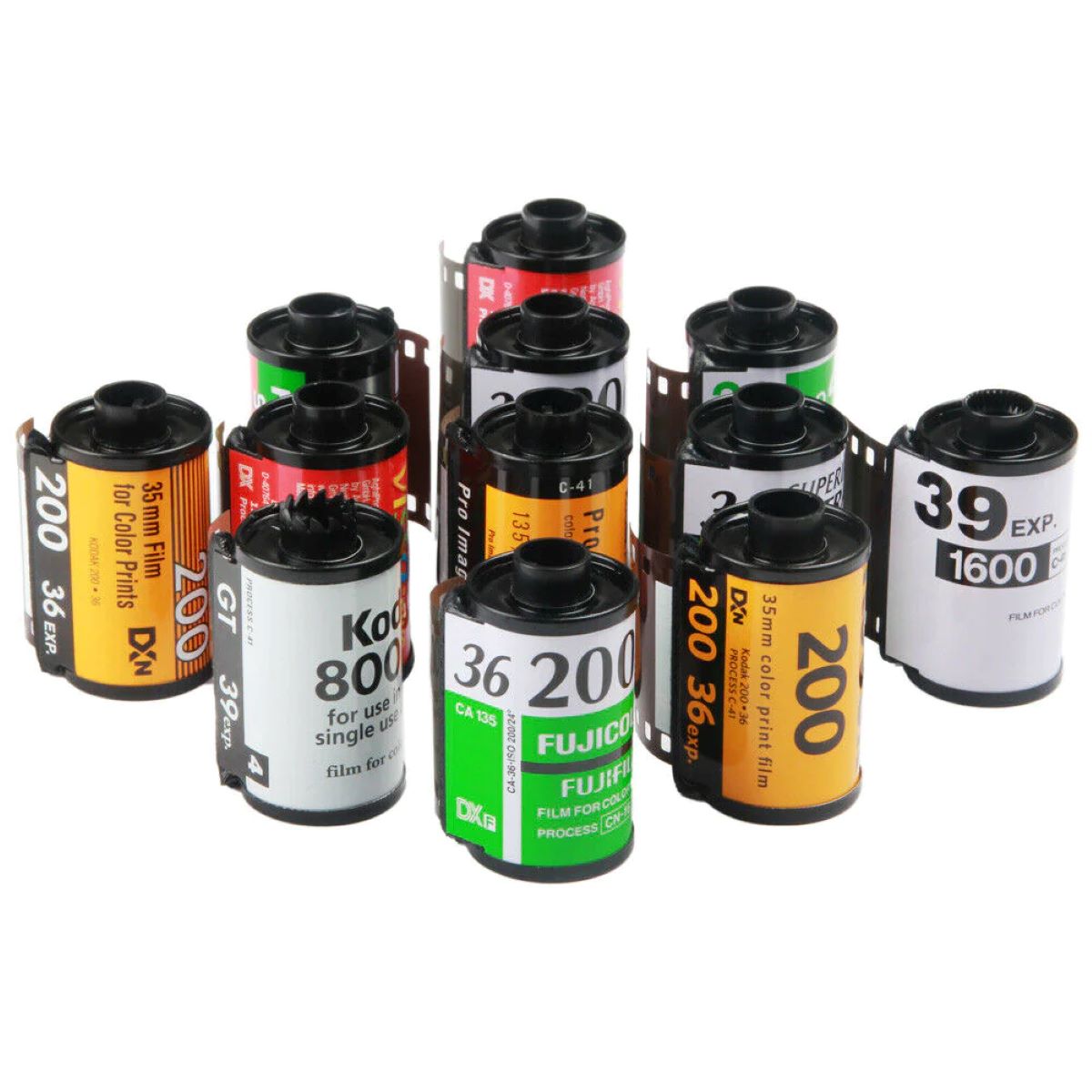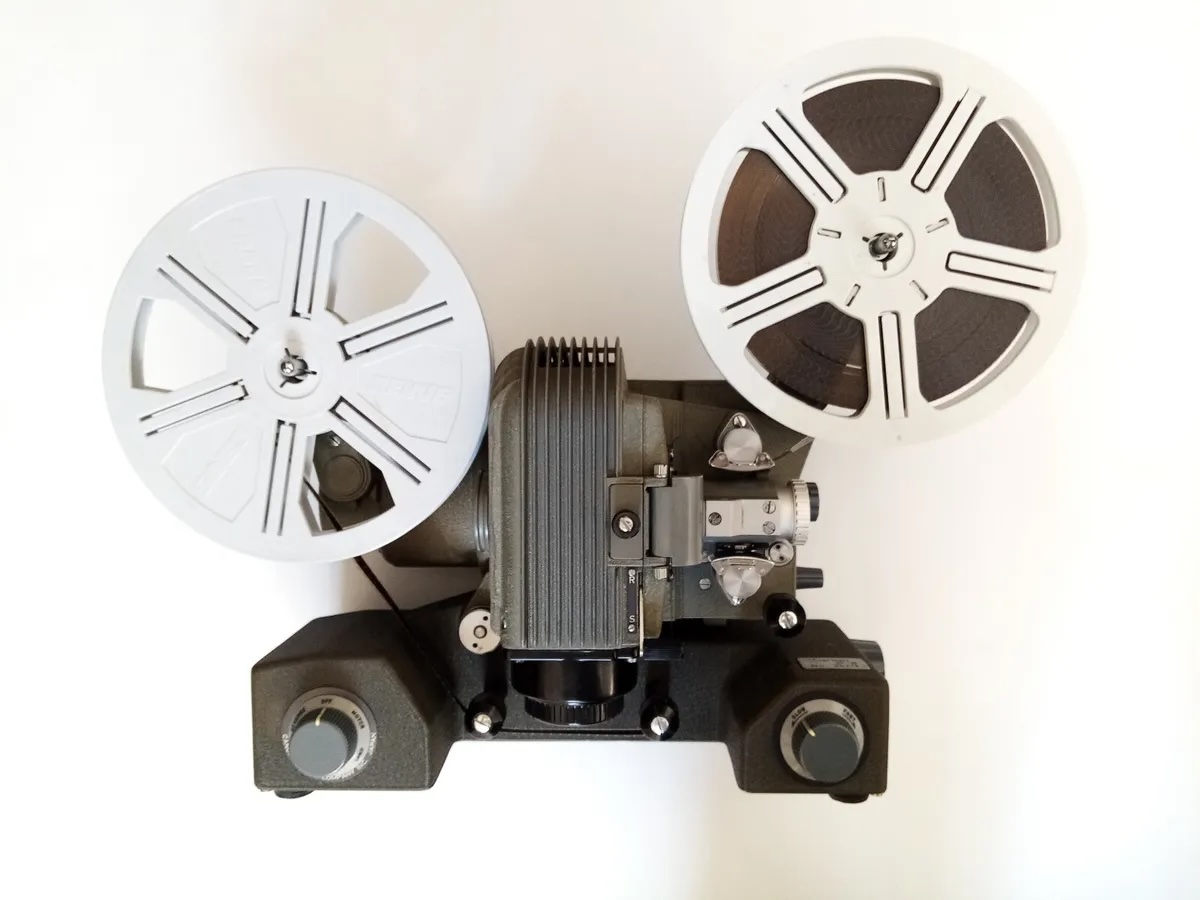

Articles
How To Store 35Mm Film
Modified: January 4, 2024
Learn the best practices for storing 35mm film and preserving its quality for years to come. Read our informative articles now!
(Many of the links in this article redirect to a specific reviewed product. Your purchase of these products through affiliate links helps to generate commission for Storables.com, at no extra cost. Learn more)
Introduction
Welcome to the world of film photography! If you’re new to shooting with 35mm film, it’s important to understand how to properly handle and store your precious rolls of film. Storing them correctly not only ensures their longevity but also maintains the quality of your photographs for years to come. In this article, we will guide you through the process of storing 35mm film, whether you’re a hobbyist archiving your personal collection or a professional maintaining a film archive.
As with any valuable item, proper handling and storage are paramount to keeping your 35mm film in excellent condition. Film is sensitive to temperature, humidity, light, and various other environmental factors that can degrade its quality over time. By following the right practices, you can protect your film from damage, prevent color shifts, and maintain optimum image integrity.
In the following sections, we will delve deeper into the specifics of properly handling and storing your 35mm film. We will explore the ideal storage environment, different storage options, both for home use and professional archives, and provide essential tips for long-term film storage. So let’s dive in and ensure your film stays safe and sound!
Key Takeaways:
- Proper handling and storage of 35mm film is crucial for preserving its quality and longevity. From using protective cassettes to controlling temperature and humidity, following best practices ensures optimal film preservation.
- Whether you’re a film enthusiast or a professional archivist, understanding the sensitivity of 35mm film to environmental factors is key. Proper storage, handling, and long-term care are essential for protecting the integrity of your cherished film collection.
Read more: How To View 8mm Film Without A Projector
Understanding 35mm Film
Before we delve into the details of storing 35mm film, let’s first understand what it is. 35mm film, also known as 135 film, is a popular format used in analog photography. It consists of a strip of celluloid with light-sensitive emulsion coated on one side. The film strip is usually 35mm wide, hence the name, and is wound on a spool inside a protective cassette.
The film strip itself is comprised of individual frames that can be exposed to light when advanced through a camera. Each standard roll of 35mm film typically contains 24 or 36 frames, although there are variations available with different frame counts.
When you expose your film to light by taking a photo, the emulsion on the film reacts to the light, capturing the image. This latent image is then developed and transformed into a visible photograph through a chemical process.
It’s important to note that 35mm film is sensitive to various environmental factors that can lead to degradation over time. These factors include temperature, humidity, light, and exposure to air pollutants. Proper storage techniques will help minimize the impact of these factors, ensuring the longevity and quality of your film.
Now that we have a basic understanding of what 35mm film is, let’s move on to the key considerations for handling and storing it correctly.
Proper Handling and Storage of 35mm Film
Proper handling and storage of 35mm film are essential for maintaining its quality and prolonging its lifespan. Here are some key tips to ensure you handle and store your film correctly:
- Keep film in its protective cassette: 35mm film comes in a protective cassette to shield it from light, dust, and physical damage. When not in use, always keep your film inside its cassette to provide an extra layer of protection.
- Avoid touching the emulsion side: The emulsion side of the film is the side with the light-sensitive coating. To avoid damaging the film or leaving fingerprints on the emulsion, handle the film by its edges or use film handling gloves.
- Store film vertically: When storing your film, whether it’s in its cassette or not, store it vertically with the label facing out. This helps prevent the film from warping or getting stuck together.
- Keep film away from extreme temperatures: Heat can cause the film to become brittle, while extreme cold can lead to moisture condensation. Store your film in a cool and dry place, away from direct sunlight, heaters, or any other sources of heat.
- Control the humidity: High humidity levels can lead to moisture-related damage, including mold growth, warping, and emulsion sticking. Aim to store your film in an environment with a humidity level between 30-50% to prevent such issues.
- Protect film from X-rays and magnets: X-rays can damage undeveloped film, so always request hand inspection at airport security checkpoints instead of sending it through X-ray machines. Additionally, keep your film away from magnets, as they can disrupt the film’s magnetic coating.
By following these handling practices, you can ensure that your 35mm film remains in optimal condition. However, proper storage is equally important in protecting the film from environmental factors that can degrade its quality over time. In the next section, we will discuss the ideal storage environment for your 35mm film.
Choosing the Right Storage Environment
When it comes to storing your 35mm film, selecting the right storage environment is crucial. The goal is to create a controlled environment that minimizes the impact of external factors on your film. Here are factors to consider when choosing the right storage environment:
- Temperature: Film should be stored in a cool environment, ideally between 50-68 degrees Fahrenheit (10-20 degrees Celsius). Avoid extreme temperature fluctuations, as they can cause the film to warp or deteriorate.
- Humidity: It is important to maintain a stable humidity level for your film. The ideal humidity range is between 30-50%, as higher levels can cause moisture-related damage such as mold growth and emulsion sticking.
- Light: Excessive exposure to light, especially ultraviolet (UV) light, can fade the colors and degrade the quality of your film. Store your film in a place that limits exposure to direct sunlight, fluorescent lights, and any other intense sources of light.
- Air Quality: Air pollutants, such as dust and chemicals, can contaminate film and cause damage. Choose a storage location that is clean and free from airborne pollutants or consider using archival sleeves or storage containers for additional protection.
It’s worth noting that maintaining a stable environment is key. Rapid changes in temperature and humidity can cause condensation to form on the film, leading to moisture damage. Additionally, avoid storing film in areas prone to excessive moisture, like basements or rooms with high humidity.
If you live in a region with challenging climate conditions, consider investing in a climate-controlled storage unit or installing a dehumidifier to regulate the environment where you store your film. This will help ensure a consistent and optimal storage environment.
Now that we’ve discussed the ideal storage environment for your film, let’s explore the different storage options available for storing 35mm film, both at home and in professional archives.
Film Storage Options
When it comes to storing your 35mm film, there are several storage options available, depending on your needs and the size of your film collection. Let’s explore some common film storage options:
- Film Canisters: Film canisters are a popular choice for storing 35mm film. These small, cylindrical containers are typically made of plastic or metal and provide a protective housing for your film. They are lightweight, compact, and can be easily labeled for organization.
- Archival Sleeves: Archival sleeves are transparent sleeves made of acid-free and archival-quality materials. They are designed to protect the film from dust, moisture, and light while allowing easy access for viewing and retrieval. Archival sleeves are commonly used in professional film archives but can also be a great option for individuals looking to store their film collection.
- Film Storage Boxes: Film storage boxes are larger, rectangular containers that can hold multiple rolls of film. These boxes are often made of acid-free materials to ensure long-term preservation of the film. Some film storage boxes come with dividers or compartments to keep the rolls organized and protected.
- Film Binders and Albums: Film binders and albums are a great option if you want to store your film in a more organized and easily accessible manner. These binders typically have plastic sleeves or pockets where you can slide your film strips, allowing you to flip through them like pages in a book. This option is a popular choice for those who enjoy browsing and showcasing their film collection.
- Chest Freezer Storage: For long-term storage of a large film collection, some professionals recommend storing film in a chest freezer. This method helps control temperature and humidity and can be a suitable option for storing film for extended periods. However, it’s important to note that caution must be taken when thawing the film to avoid potential condensation damage.
When selecting a storage option, consider factors such as accessibility, organization, protection, and the size of your film collection. Choose a method that best suits your needs and ensures the safety and preservation of your 35mm film.
Now that we’ve covered various storage options, let’s explore how to store 35mm film at home, whether you have a small personal collection or a larger film archive.
Store 35mm film in a cool, dry place away from direct sunlight and extreme temperatures. Airtight containers or resealable bags can help protect the film from moisture and dust.
Read more: How To Store Film
Storing 35mm Film at Home
If you are a film photography enthusiast with a small collection of 35mm film, storing them at home can be easily managed with proper care and organization. Here are some tips for storing your 35mm film at home:
- Choose a cool and dry storage location: Find a cool, dry, and stable environment in your home to store your film. Avoid areas that are prone to temperature fluctuations, high humidity, or excessive sunlight exposure.
- Consider using film canisters: Film canisters are a convenient storage option for individual rolls of 35mm film. Make sure the film is properly rewound and placed inside the canisters to protect them from dust, light, and physical damage.
- Label and organize your film: Proper labeling and organizing your film will make it easier to locate specific rolls when needed. Use markers or labels to indicate the type of film, date, and any other relevant information.
- Store film vertically: Storing your film vertically, with the canister or box standing upright, helps prevent warping or sticking of the film. It also makes it easier to view and access specific rolls without disturbing others.
- Use archival sleeves or boxes: If you want to provide extra protection for your film, consider using archival sleeves or boxes. These acid-free and archival-quality materials help prevent the film from coming into contact with dust, moisture, and light.
- Regularly inspect and maintain your film: Periodically check your stored film for any signs of damage, such as mold growth or physical deterioration. If you notice any issues, take immediate action to prevent further damage or loss.
By following these guidelines, you can safely store and maintain your 35mm film collection at home. However, if you have a larger film archive or require professional preservation, there are specialized options available for storing your film.
In the next section, we will discuss the process of storing 35mm film in professional film archives.
Storing 35mm Film in Professional Archives
Professional film archives play a crucial role in preserving and safeguarding valuable film collections. If you have a substantial 35mm film collection or require specialized preservation, storing your film in a professional archive may be the best option. Here’s what you need to know about storing 35mm film in professional archives:
- Temperature and humidity-controlled environment: Professional film archives maintain a stable temperature and humidity level to ensure the longevity of the film. These controlled environments help minimize the risks of deterioration, mold growth, and other moisture-related damage.
- Proper film barcoding and cataloging: Film archivists employ sophisticated barcoding and cataloging systems to track and locate specific film reels within their collections. This ensures easy access, retrieval, and monitoring of the stored film.
- Specialized film vaults: Film archives typically have dedicated film vaults equipped with advanced security measures. These vaults are designed to protect film from light, humidity, temperature fluctuations, and physical damage. They often feature fire suppression systems and regulated access to prevent unauthorized handling of the film.
- Handling by trained professionals: Professional film archivists are well-versed in the careful handling and preservation of film. They ensure correct handling techniques, use protective gloves, and follow industry best practices to minimize the risk of damage during storage and retrieval.
- Digitization and preservation efforts: Many professional film archives are actively involved in digitizing and preserving film collections. This helps to ensure the long-term accessibility and preservation of the film for future generations, even as the industry moves toward digital formats.
Storing your 35mm film in a professional archive provides an extra layer of security and expertise in preserving and maintaining the quality of your film collection. However, it’s important to research and choose a reputable archive with a proven track record in film preservation.
Now that we have explored storing 35mm film in both personal and professional settings, let’s move on to some essential tips for long-term film storage, regardless of the storage method.
Tips for Long-Term Film Storage
Proper long-term storage is vital for ensuring the longevity and quality of your 35mm film. Whether you’re storing your film at home or in a professional archive, here are some essential tips to keep in mind:
- Regularly inspect and monitor your film: Regularly check your film for any signs of damage such as mold, discoloration, or physical deterioration. This allows you to take immediate action to prevent further degradation or loss.
- Avoid extreme temperature and humidity fluctuations: Keep your film in a stable environment with consistent temperature and humidity levels. Avoid exposing it to extreme hot/cold temperatures or rapid fluctuations, as these can cause damage and deterioration.
- Minimize exposure to light: Light, especially UV light, can fade colors and degrade the quality of your film. Store your film in a dark or low-light environment, away from direct sunlight or strong artificial lighting.
- Handle film with care: When handling your film, always do so with clean hands or disposable film handling gloves. Avoid touching the emulsion side and take precautions to prevent scratches or tears while loading or unloading the film.
- Keep film away from magnetic fields: Magnetic fields can damage the magnetic coating on some film types. Avoid storing your film near speakers, magnets, or any other magnetic devices to prevent potential data loss or interference.
- Create backups or duplicates: Consider making duplicate copies or backups of your most valuable or irreplaceable film rolls. This provides an extra layer of protection in case of damage or loss.
- Keep detailed records: Maintain a detailed catalog or inventory of your film collection, including information such as film type, date, and any other relevant details. This helps you track and manage your collection more effectively.
- Follow film-specific storage recommendations: Different types of film may have specific storage requirements based on their emulsion, base, or formats. Refer to the manufacturer’s recommendations or consult with professionals for specific guidelines on storing your particular film stock.
By following these tips, you can ensure that your 35mm film remains protected and well-maintained for years to come. Whether you’re storing your film at home or in a professional archive, proper long-term storage practices are crucial in preserving its quality.
With the right storage techniques, you can enjoy your film collection and the cherished memories it holds for generations to come.
Now, let’s conclude this article and summarize the key points we’ve discussed.
Maintaining Film Quality
Maintaining the quality of your 35mm film is essential to preserving its integrity and ensuring that your photographs stand the test of time. Here are some key factors to consider in order to maintain film quality:
- Proper handling: Handle your film with care, avoiding touching the emulsion side and taking precautions to prevent scratches or tears. Use clean hands or disposable film handling gloves to minimize the transfer of oils and dirt onto the film. This will help maintain the quality of the emulsion layer.
- Correct exposure: Ensure proper exposure when capturing images on your 35mm film. Incorrect exposure, such as overexposure or underexposure, can significantly impact image quality and make it challenging to salvage details in post-processing.
- Avoid extreme temperatures: Excessive heat can cause film to become brittle and lead to discoloration or warping, while extreme cold can lead to moisture condensation. Store your film in a cool and stable environment, away from direct sunlight or sources of heat.
- Control humidity levels: High humidity can cause moisture-related damage, including mold growth, warping, and emulsion sticking. Aim to store your film in an environment with a humidity level between 30-50% to mitigate such risks.
- Protect from light: Prolonged exposure to light, especially UV light, can fade colors and degrade the quality of your film. Keep your film stored in a dark or low-light environment, away from direct sunlight or strong artificial lighting.
- Store film properly: Follow proper storage techniques, such as using film canisters, archival sleeves, or storage boxes to protect your film from dust, light, and physical damage. Store film vertically with the label facing out to prevent warping or sticking.
- Regularly inspect your film: Periodically examine your stored film for any signs of damage, such as mold growth or physical deterioration. Early detection can help you take necessary measures to prevent further degradation or potential loss of the film.
- Digitize or make duplicates: Consider digitizing your film or creating duplicate copies, especially for your most valuable or irreplaceable rolls. This provides an additional backup and preserves your images in a digital format that can withstand the test of time.
By implementing these practices, you can maintain the quality of your 35mm film and ensure that your photographs retain their original beauty and detail. Remember that proper handling, storage, and care are crucial in protecting the longevity and integrity of your film-based images.
Now, let’s conclude this article and summarize the key points we’ve discussed throughout.
Read more: How To Store Polaroid Film
Conclusion
Proper handling and storage of 35mm film are vital to preserve its longevity and maintain the quality of your photographs. Whether you’re a film photography enthusiast with a small personal collection or a professional archiving a vast film archive, following the right practices can ensure the safety and preservation of your film for years to come.
Understanding the nature of 35mm film and its sensitivity to environmental factors is the first step in proper film storage. By keeping your film in its protective cassette, avoiding touching the emulsion side, and storing it vertically, you can minimize the risk of damage during handling.
Choosing the right storage environment plays a crucial role in maintaining film quality. Controlling temperature, humidity, and light exposure are all essential factors to consider. Additionally, protecting film from x-rays and magnets is essential to prevent potential damage to the film and its magnetic coating.
Depending on your needs and the size of your film collection, various storage options are available. Film canisters, archival sleeves, film storage boxes, and binders/albums all provide ways to store and organize your film effectively. For larger collections or specialized preservation, professional film archives offer temperature-controlled environments, specialized handling, and advanced storage facilities.
Tips for long-term film storage, such as regular inspection, avoiding extreme temperature and humidity fluctuations, and creating backups or duplicates, will ensure maximum protection for your film collection. By following these guidelines and maintaining film quality, you can enjoy the beauty and nostalgia of film photography for many years to come.
Remember, 35mm film is not just a medium for capturing images, but a piece of history and art. Properly handling and storing it is an essential part of preserving that history and ensuring that future generations can experience the beauty and significance of analog photography.
So, whether you’re a film photography enthusiast or a professional working with film archives, take the time to handle and store your 35mm film with care. Your efforts will pay off in preserving the integrity and quality of your cherished film collection.
Frequently Asked Questions about How To Store 35Mm Film
Was this page helpful?
At Storables.com, we guarantee accurate and reliable information. Our content, validated by Expert Board Contributors, is crafted following stringent Editorial Policies. We're committed to providing you with well-researched, expert-backed insights for all your informational needs.














0 thoughts on “How To Store 35Mm Film”